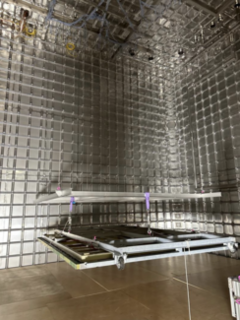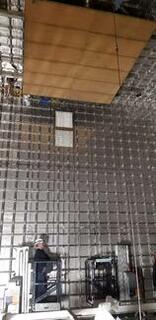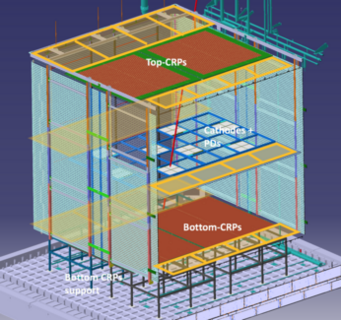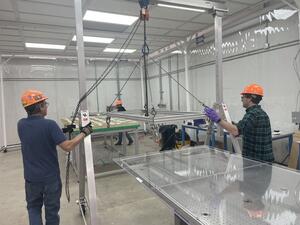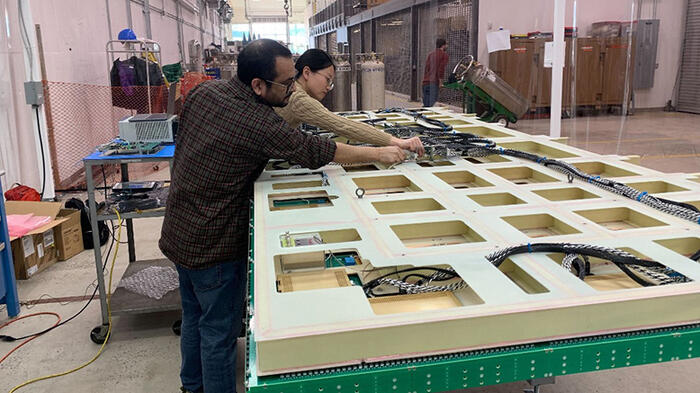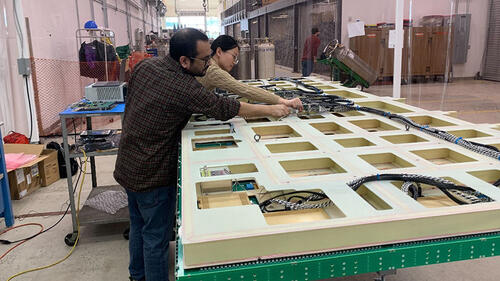
A team of researchers and technical staff from Yale’s Wright Laboratory (Wright Lab), in collaboration with researchers from the Department of Energy’s Brookhaven National Laboratory’s (BNL) Electronic Detector Group, the University of Chicago; and the University of Iowa, has successfully assembled and tested the first Charge Readout Planes (CRPs) at Wright Lab for the international Deep Underground Neutrino Experiment (DUNE) at the Sanford Underground Research Facility (SURF) in Lead, South Dakota. The readout planes are an integral part of the novel liquid-argon detector to study the interactions of neutrinos. The completed CRP was shipped to CERN, the European Organization for Nuclear Research, in February, for testing in CERN’s ProtoDUNE facility.
The Deep Underground Neutrino Experiment (DUNE)
Image Credit: Fermilab
DUNE is the world’s largest neutrino experiment; an international effort aimed at solving some of the open questions about neutrinos. Studies over the past several decades suggest that neutrinos have a small but finite mass and undergo flavor oscillations. DUNE will explore neutrino oscillation with unprecedented detail and could potentially discover matter-antimatter asymmetries.
DUNE is currently under construction, and physics data taking is scheduled to start in 2028. The experiment will send a high-energy neutrino beam, with an intensity of 1.2 MW, over a distance of 1,300 km through the Earth’s crust from Fermilab in Batavia, IL to SURF in South Dakota. At SURF, neutrinos will be detected in massive 17 kiloton Liquid Argon (LAr) Time Projection Chambers (TPC) equipped with technology to image neutrino interaction and tracks in the detector.
The DUNE CRPs are the basic readout components of the detector modules; the mechanism that translates the data obtained by the DUNE experiment into machine-readable output. They are a crucial component of the detector technology of DUNE.
Technology verification in ProtoDUNE
Photos of ProtoDUNE at CERN courtesy of Flavio Cavanna. Drawing of ProtoDUNE detector configuration courtesy of CERN.
ProtoDUNE detectors at CERN are designed to test the technologies and techniques that will be used in the full-scale DUNE experiment. The first ProtoDUNE detector started operations in September 2018, and a second prototype detector is now being prepared for testing at CERN.
A collaborative effort at Wright Lab
Wright Lab is one of the CRP assembly sites in the international DUNE collaboration. The recent CRP assembly effort at Wright Lab has been a collaboration between Yale University, Brookhaven National Laboratory (BNL)-–which has a strong research partnership with Yale, including a long-standing collaboration in the physical sciences-–the University of Chicago, and the University of Iowa; led by Principal Investigator Karsten Heeger, Eugene Higgins Professor of Physics at Yale, chair of the Yale Physics Department, and Director of Wright Lab.
Heeger said, “Wright Lab’s unique facilities and infrastructure–including high bay assembly space, expert technical professionals, and dedicated support personnel–were critical for the recent successful work for DUNE”.
In addition to Heeger, Wright Lab’s Govinda Adhikari, postdoctoral associate; James Wilhelmi, research support specialist; Lee Hagaman, graduate student; Jeff Ashenfelter, operations director; and research technicians Tom Hurteau, Frank Lopez, and Craig Miller participated in this effort.
Adhikari said, “I am pleased with the hands-on experience and lessons learned from setting up a clean room, conducting the assembly, and testing of CRPs in various temperatures. Wright Lab is equipped with the necessary resources, and provided an exceptional environment for the successful production of one of the vital components of the far detector for the DUNE experiment.”
Adhikari continued, “Our team has developed the necessary competencies and confidence to consistently produce charge readout planes, which is critical in meeting the goals of the collaboration.”
Collaborators from other institutions include Augie Hoffman, Hanjie Liu, and Matt Worcester from BNL; Chris Macias from the University of Iowa; and Avinay Bhat, a recent Wright Lab postdoctoral alumnus who is now at the University of Chicago.
Assembly
Assembly of the DUNE charge readout planes at Wright Lab. Images courtesy of Yale Wright Laboratory/James Wilhelmi.
Charge Readout Planes (CRPs) are assembled with perforated printed circuit boards (PCBs) and attached to a composite frame that provides mechanical support and planarity. Warm and cold test electronics and cables are mounted, and the whole assembly is placed inside a “cold box” for testing at both room and cryogenic temperatures. Once the tests are successful, the CRP is packaged and sent to CERN for testing at the ProtoDUNE facility. The team is eagerly anticipating the test results from the ProtoDUNE setup at CERN.
This article is taken from the Wright Lab News article of March 3, 2023, by Victoria Misenti. Photos from the assembly process can be found on Flickr, linked below.

